
Johns Hopkins UniversityEst. 1876
America’s First Research University
From Here to There: The Complexity of 1-Click Ordering


To the average consumer, Amazon appears Oz-like with its magical power of 1-click ordering. For publishers, authors, and distributors, we have glimpses of the shadowy figure behind the curtain. Instead of smoke and mirrors, we deal with inscrutable algorithms, and in place of wanting to go home, we want to be in stock and on sale.
When I started in publishing, authors wanted to see their books shelved at their local bookstore and at national chains. Shelf-space is an even rarer commodity these days, but Amazon book detail pages have supplanted that coveted in-store spot. Once books are finalized, book metadata is pushed to retail and wholesale accounts. From there, the data spreads throughout the internet. There is then a second layer of book data that relates to physical stock. When Amazon orders from HFS, we receive electronic files and respond in kind confirming the order and providing specific details about the availability of each book. That information is usually reflected on the individual book detail pages and relates to the book’s availability.
“Availability” can take on many meanings. Often, online retailers only have the data, not actual books, and are able to sell based on inventory at wholesale accounts. Amazon uses the book metadata and order data to let customers know if a book is in stock and how quickly it can ship. Amazon has also used availability as leverage over publishers.
This shows a standard buy-box, with everything appearing as it should. This status is often more difficult to achieve than customers realize.
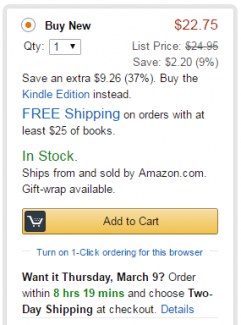
The example below shows as in stock, but there are only four copies available. In my experience, the “in stock” numbers are usually more about creating a sense of urgency to buy than actual stock numbers. Books can always be sourced from wholesalers or direct to meet demand.
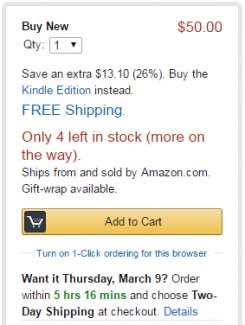
We’ve noticed changes to Amazon’s buying patterns over the last 1–2 years, and they now hold fewer books in stock and manage more sales with “just-in-time” inventory. Unfortunately, that can lead to this message:
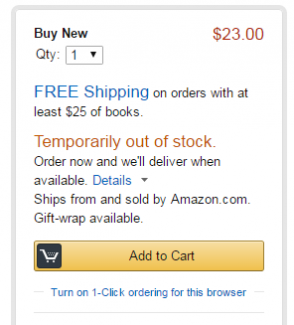
Amazon will order based on demand, but the messaging is a bit of a deterrent if the customer wants the book right away. The upside is that returns are down substantially over this time a year ago.
Ideally, not-yet-published books will have a pre-order link. These books are frequently sold at a discount to provide further incentive.
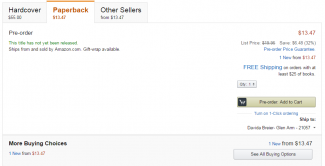
Something else to note are the size and options of the buy box, which further influence customer behavior.

A recent trend is that used books are frequently given ordering preference, frustrating authors and publishers. Below is a solid backlist title, and the first buying option is for a used copy and customers have to look for the new option.
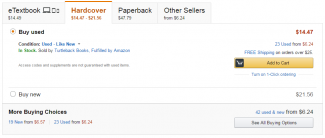
Something else Amazon does is manipulate searches. In fact, publishers can pay to influence search results, which means that some search results are, in fact, paid promotions.
The 36-Hour Day is one of JHUP’s best-known titles. I searched “36 hour day” and the top search results provided information about three different editions.
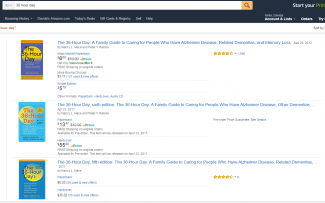
When I clicked on the link for the current edition, I was taken to this page, again, promoting a used copy:

Under the related links, I saw the edition I was looking for and, finally, I had the option to purchase the book as new or in different editions and formats:

Below is a good example of the exasperation authors and publishers face. The detail page for this title shows the book as available in 1–2 months, only we shipped stock almost a week ago and it is likely sitting on Amazon’s loading dock. Furthermore, there is a second order being picked and packed and there is inventory at the wholesalers. There is no explainable reason for this book to show as out of stock.
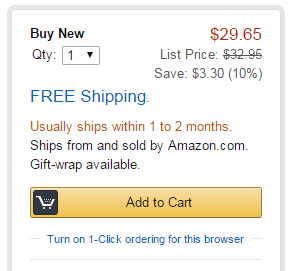
This brings me back to the data. Buy boxes are often the best place to tell there is a problem with the book metadata or ordering data. If a publisher contacts me to find out why a book is unavailable, I begin by researching the metadata that was sent to Amazon, the order data in our system, and the book data in Amazon’s system. Often the answer is simple – they haven’t ordered recently, but if there is expected demand, Amazon needs to be told so they can order. Other times, it is due to Amazon having delinked the book in their system and we need to get them to link back to us for ordering. Behind the scenes, Amazon links each book to a distributor, wholesaler, or publisher for stock. If that link isn’t correct, sourcing becomes an issue.
As a distributor, our goal is making books available to readers, which takes a bit of heel-clicking and troubleshooting.
Davida G. Breier, Manager of HFS, worked at two book distributors prior to joining JHUP in 2010. She also sits on the board of No Voice Unheard, a non-profit publisher, and was a contributing writer and photographer for the book Ninety-Five: Meeting America’s Farmed Animals.

